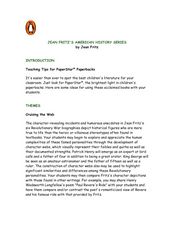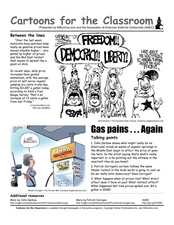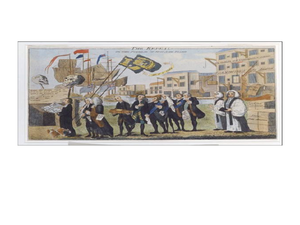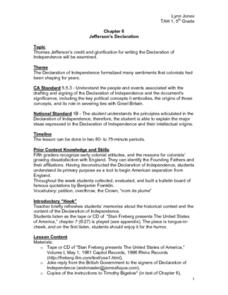National Endowment for the Humanities
Nathaniel Hawthorne and Literary Humor
Young scholars examine Nathaniel Hawthorne's style of humor and compare it to other humorists. They discuss the purpose of literary humor and determine how it develops characters and plots in stories. They analyze the use of different...
National Endowment for the Humanities
Mark Twain and American Humor
“The Celebrated Jumping Frog of Calaveras County” is famous, in part, because it established a uniquely American form of humor. For this famous story, Mark Twain combines the tall-tale, the dialect story, and satire. Here is a resource...
Curated OER
Anonymous Patriots: Songs of the Revolution
Give your class a deeper understanding of the context and meaning behind early American song lyrics. By reading the lyrics to "Yankee Doodle" and "Revolutionary Tea," high schoolers will practice analysis by examining the...
Curated OER
Grapes of Wrath: Setting up Historical Context
Discuss life in the 1930s in relation to the Dust Bowl and Great Depression, then do a cross-media analysis. Here you'll find background information on film maker John Ford, writer John Steinbeck, and 1930s America. You can compare the...
National Endowment for the Humanities
"Old Southwest" Humorists and George Washington Harris
Young scholars discover the work of George Washington Harris and his influence on American humor. For this George Washington Harris lesson, discuss cultural differences in the United States and read Sut Lovongwood stories by George...
Curated OER
American Literature Unit Four
Students prepare for and respond to literature selections. This package includes twelve lessons from the American Literature, Regionalism and Realism: 1865-1910 series, each covering a different reading selection. Pre-reading and...
Curated OER
Cartoons for the Classroom: Sarcasm, Irony, and Satire
Satire, sarcasm, or irony? Editorial cartoons have long been the tool artists use to express their opinions about politics and politicians. Kevin "Kai" Kallaugher's four-panel cartoon offers readers an opportunity to examine how he uses...
Benjamin Franklin Tercentenary
B. Franklin, Printer and the Public Eye
Students explore U.S. history by researching famous Americans. In this Benjamin Franklin lesson plan, students read portions of a biography about Franklin and identify his position within U.S. politics and as a leader in the battle for...
Curated OER
In 'Other words' Writing Gently Humorous Essays About Stereotypes
Define and understand what stereotypes are by reading an article with stereotyping in it. Students will locate how it shows stereotyping and answer questions about the stereotypes. Finally, they will write their own pieces of original work.
Curated OER
Jean Fritz's American History Series
Students explore children's literature by reading biographies in class. In this history analysis activity, students read books written by Jean Fritz about the Revolutionary War and discuss the events that led up to the critical moment....
Curated OER
Cartoons in the Classroom: Gas Pains Again
The price of gas has increased around the country, and many political cartoons, such as this one, have used humor to get people thinking about it. With the help of three very good critical thinking prompts, learners will analyze a...
Curated OER
Editorial Cartoons: A Historical Example of Immigration Debates
Eleventh graders analyze political cartoons. In this American History lesson, 11th graders research the Chinese Exclusion Act and the current arguments about immigration to the United States. Students create a graphic...
Curated OER
Cartoons for the Classroom: 9/11 Revisited
Political cartoons about the September 11 terrorist attacks provide an opportunity for class members to analyze the inferences embedded in the drawings.
Curated OER
American Deaf Culture: Deaf Art
Learners examine the culture and art of the Deaf Community. They discover the history of the Deaf Community using art and their values. They compare and contrast different pieces of art.
Curated OER
Cartoons for the Classroom: What's Next in 2011?
Examine the toolbox of political cartoons with this analysis handout, which features a cartoon utilizing satire, sarcasm, and irony as it predicts the current events of 2011. Interestingly, this will also serve to get scholars looking...
Curated OER
The Art of Political Cartoons in Revolutionary America
Young scholars analyze political cartoons. In this colonial America lesson, students examine the provided political cartoons and respond to analytical questions about each of them.
Curated OER
Curriculum Connections with Keiko Kasza
Students read books by the author Keiko Kasza and complete critical thinking skills, and connections to different subjects. For this language lesson plan, students connect the books to language arts, social studies, science, math,...
Curated OER
Cartoons for the Classroom: What's Next for us in 2011?
In this current events worksheet, students analyze a political cartoon about predictions for 2011 and respond to 3 talking point questions.
Curated OER
Multicultural Fairy Tales -- The Stuff of Magic
Third graders are introduced to the characteristics of fairy tales. After being read some examples, they write their own fairy tale based on their adventures on a magic carpet ride after making a chart to organize their thoughts. To...
Curated OER
Political Cartoons
Young scholars analyze cartoons by identifying the symbols, characters and information and its significance in history. They examine the economic and political changes in contemporary America. They determine that political cartoons play...
Curated OER
Jefferson's Declaration
Fifth graders understand the people and events associated with the
drafting and signing of the Declaration of Independence and the document's significance. They identify the Founding Fathers and
their affiliations. As the lesson...




















